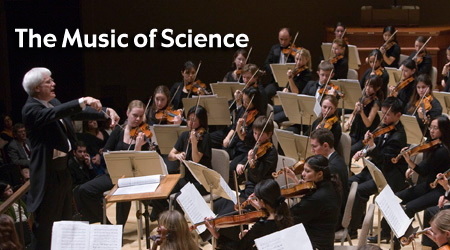Podcast: The Music of Science
- By Maggie Masetti
- November 30, 2009
- 2 Comments

Click to listen! (6.7MB MP3, right-click to save)
Transcript (Text, PDF)
The evening of November 2, 2009 was the world premiere of “Cosmic Reflection,” an orchestral composition inspired by one of NASA’s satellites, in Washington, DC. This opus began as a simple prelude inspired by (and performed by a brass quintet at) the launch of the GLAST mission. To celebrate the first birthday of this satellite (since renamed Fermi), composer Dr. Nolan Gasser wrote a symphony which uses music to aurally portray the history of the universe.
We were able to go backstage at the Kennedy Center on the day of the performance to speak to a few of the people involved in this project, including the composer, the producer, a NASA scientist, and the “voice” of Cosmic Reflection.
More about Cosmic Reflection
Watch the GLAST Prelude:
If you’d like to read more about how Cosmic Reflection came to be, check out these websites:
- Cosmic Reflection – the official home of the project, produced by Classical Archives
- GLAST Prelude and Cosmic Reflection – information from composer Dr. Nolan Gasser, including background, links, and interviews
Cosmic Reflection was performed by the Boston University Symphony. There is more information about the ensemble here:
More information about the Fermi Gamma-Ray Space Telescope is available here:
| Host | Sara Mitchell |
| Guests | Nolan Gasser Pierre Schwob Peter Michelson Carey Harrison |
| Interviewers | Sara Mitchell Maggie Masetti |
| Editor | Sara Mitchell |
| Theme Music | Naked Singularity |
| Additional Music | Nolan Gasser |
| Transcript | Eric Winter Maggie Masetti |
| Website Support | Meredith Gibb Maggie Masetti |
| Producer | Sara Mitchell |
| Responsible NASA Official | Kim Weaver |
The “Featured Image” for this podcast was used with permission and is credited to Michael Lutch. It shows David Hoose conducting the Boston University Symphony Orchestra.



The idea of music illustrating the history of our Universe is intriguing. I can imagine that such a piece could even reveal its creator’s own perception of the Cosmos.
I’d love to hear a composition created from the various “sounds” of our Universe, such as Jupiter’s radio waves and the Sun’s acoustical pressure waves.
As someone who plays in a local orchestra, it is always interesting to me to see how the arts can be used to convey a message, a concept or information. The golden record aboard Voyager, the Sistine Chapel ceiling, The Art of Exploration painting for MRO and a simple photograph of an astronaut’s bootprint on the Moon are all great examples. To tackle GLAST in this way must have been a pretty daunting task!